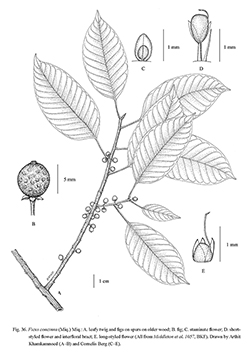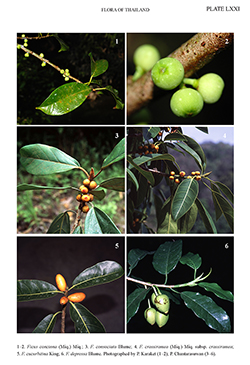e-Flora of Thailand
Volume 10 > Part 4 > Year 2011 > Page 611 > Moraceae > Ficus
URO11. Ficus concinna (Miq.) Miq.wfo-0000687884
Ann. Mus. Bot. Lugd. Bat. 3: 286. 1867; Kochummen, Tree Fl. Malaya 3: 144. 1978; Kochummen, Tree Fl. Sabah & Sarawak 3: 234. 2000; C.C.Berg & Corner, Fl. Males., Ser. 1, Spermat. 17(1): 605. 2005.— Urostigma concinnum Miq., London J. Bot. 6: 570. 1847.— Ficus glabella var. concinna (Miq.) King, Ann. Roy. Bot. Gard. (Calcutta) 1(1): 50. 1887. Fig. 36. Plate LXXI: 1–2.
Accepted Name : This is currently accepted.
Synonyms & Citations :
Description : Tree, to 20(–30) m tall, hemi-epiphytic. Branches drying pale to dark brown. Leafy twigs 1–2 mm thick, slightly angular to subterete, glabrous. Leaves spirally arranged; lamina oblong, elliptic or lanceolate (or subovate), 4–13 by 1–5 cm, (sub)coriaceous, apex (short-)acuminate, the acumen acute to obtuse, base cuneate to obtuse (or rounded); both surfaces glabrous; cystoliths only below (or on both sides); lateral veins (6–)8–13 pairs, the basal pair to ca ⅒–⅙ the length of the lamina, unbranched, tertiary venation reticulate to partly parallel to the lateral veins; waxy gland at the base of the midrib; petiole 1–2.5(–3.5) cm long, 1–1.5 mm thick, glabrous, the epidermis persistent; stipules 0.2–0.5(–3.5) cm long, white puberulous or glabrous, caducous. Figs axillary or on minute spurs just below the leaves, in pairs or solitary; with a peduncle 0.1–0.3(–0.5) cm long (or subsessile); basal bracts 3,0.5–1.5(–2.5) mm long, ciliolate, caducous (or subpersistent to persistent?); receptacle subglobose, 0.4–0.6 cm diam. When dry, 0.6–0.8 cm diam. When fresh, (sub)glabrous, turning from white to pink and then purple to black at maturity, apex convex, ostiole ca 1.5 mm diam., slightly prominent to flat, the upper ostiolar bracts ciliolate; internal hairs absent or very sparse. Staminate flowers near the ostiole. Tepals red(dish). Ovary red-brown.
Thailand : NORTHERN: Mae Hong Son, Phayao, Tak; NORTH-EASTERN: Phetchabun, Loei; SOUTH-WESTERN: Kanchanaburi, Phetchaburi, Prachuap Khiri Khan; CENTRAL: Nakhon Nayok, Krung Thep Maha Nakhon (Bangkok); SOUTH-EASTERN: Chon Buri; PENINSULAR: Ranong, Phuket, Nakhon Si Thammarat, Trang, Satun, Songkhla, Yala, Narathiwat.
Distribution : Sikkim, Bhutan, India (NE, Andaman Islands), Bangladesh (?), Burma, S China, Laos, Vietnam, Cambodia, Peninsular Malaysia and Bornean Malaysia (Sabah: Gaya Island), Indonesia (S Sumatra?), the Philippines (type).
Ecology : Evergreen, dry evergreen and deciduous dipterocarp forests, often in rocky places along rivers, to 1,400 m; also cultivated.
Vernacular : Krang (กร่าง), krai (ไกร), sai krang (ไทรกร่าง)(Bangkok); hai hi (ไฮฮี)(Phetchabun).
Notes: The basal bracts are usually caducous; they may sometimes drop later than normal or even be persistent, as in Charoenchai 126 from Nakhon Nayok, Gardner ST2606 from Phuket, and Koyama et al. 34074 from Nakhon Si Thammarat, and then the species is only distinguishable from related species, such as Ficus virens, by the short petiole, and in Thailand also by the glabrous upper ostiolar bracts. The form with (sub?)persistent basal bracts may also be represented by the type of F. affinis Kurz, but this type could not be found.


